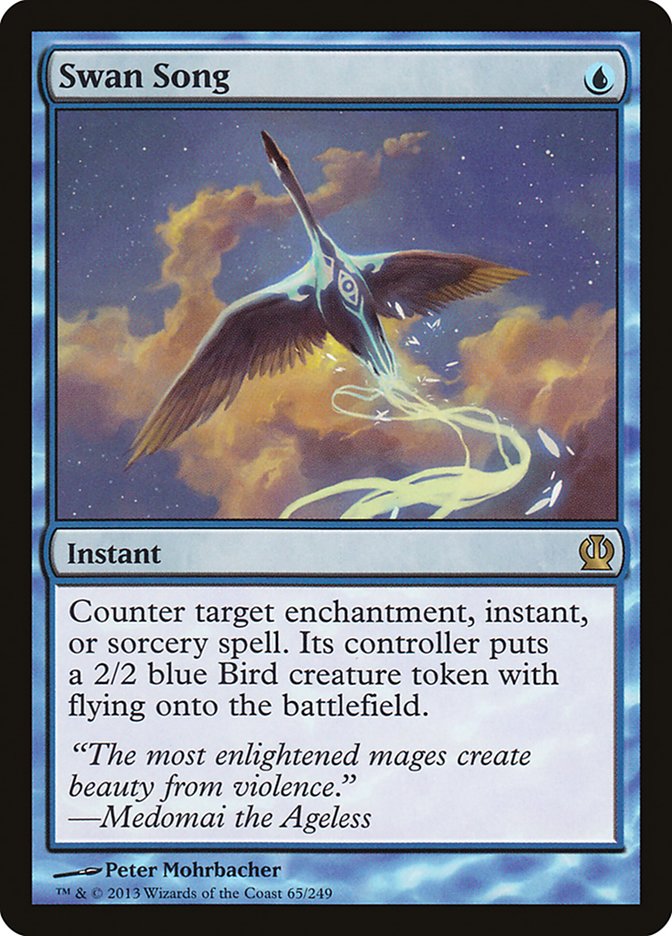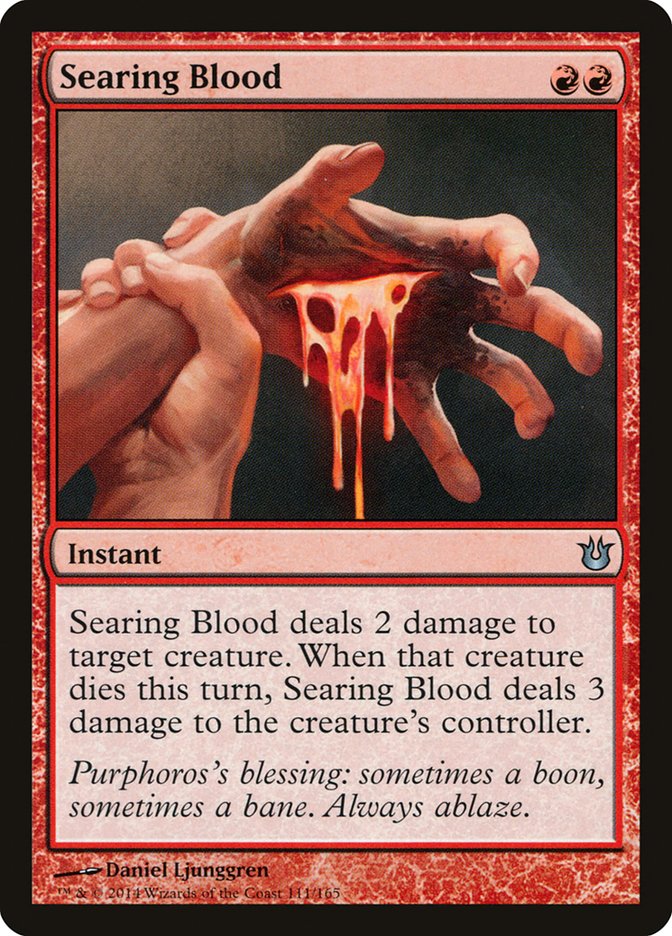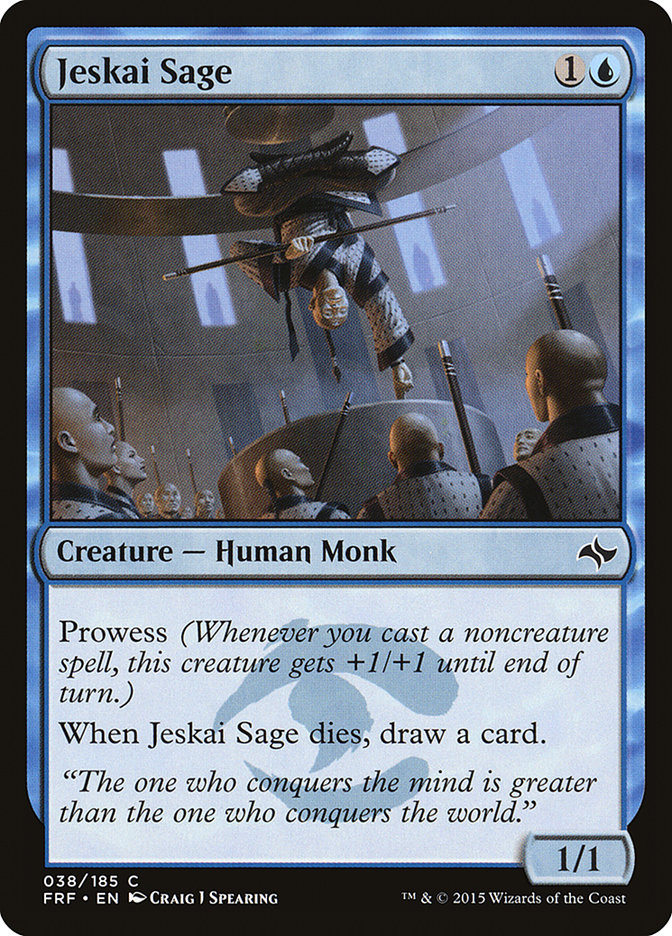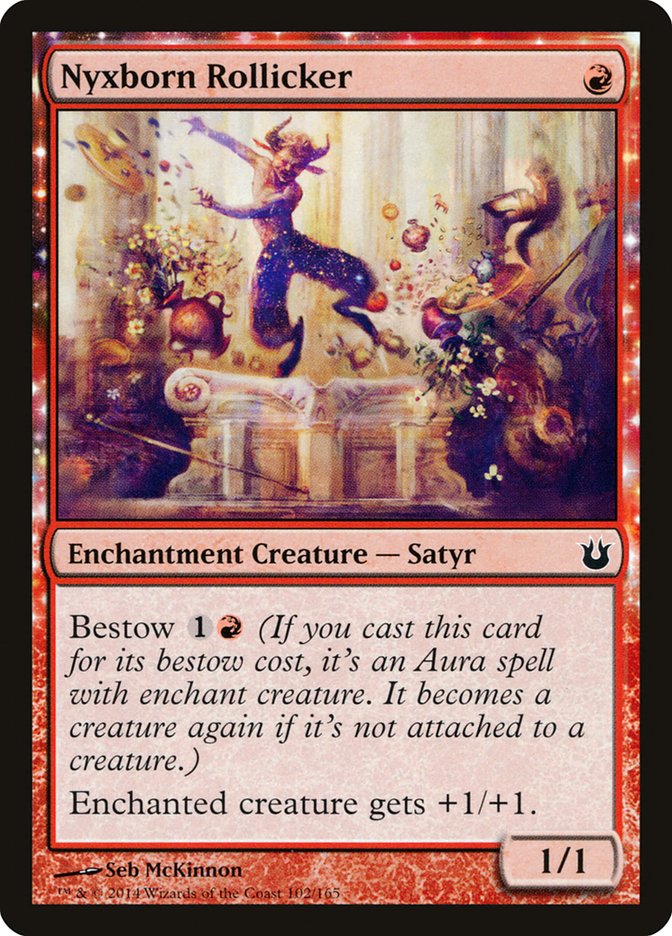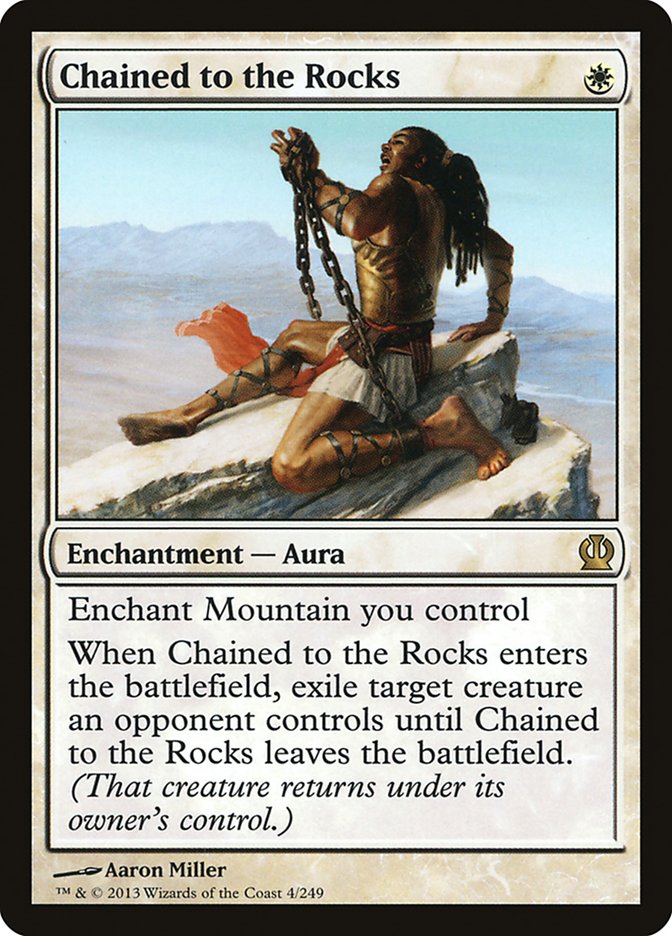With Fate Reforged spoilers in full swing, it’s tempting to take a look at the new cards and consider both new archetypes and direct improvements for
existing ones. While future weeks will contain plenty of discussion on Fate Reforged’s impact on Standard and older formats, I’d like to return to three
basic questions of deckbuilding so we can make sure we as brewers are prepared to build with the correct mindset.
What are you doing, how are you doing it, and why is this way the best to do what you’re doing?
Most deck concepts start with just one card, whether it’s a card that’s inherently powerful, could possess strong synergies, or you just want to play it.
That last one is important; in your brewing, how many decks have you built around a concept that just feels good? All the pieces are there and the
format seems right, and you’ve found a nifty little concept that you want to flesh out a bit. Nine times out of ten, you’re really just in it to play that one card.
Once you’ve picked that card, you ask yourself what you want to do with it, how you will back it up, and then why your card choices are the best based on
reasoning. Sometimes it’s just preference, frankly.
In this case, I had already established the baseline through all three questions with the simple, but potentially potent combination of two cards.
Swan Song is a powerful hard counter with a significant downside, and Searing Blood is a conditional removal spell. Together though, both will always have
a target. Counter their spell, then kabob the bird with Searing Blood to deal three damage. Straightforward and simple.
This is not a new combo; almost a year ago, I believe Gerry Thompson highlighted a deck that utilized this interaction as a means to efficiently counter
noncreature spells without having to deal with the annoying 2/2 Bird. With the addition of prowess in Khans of Tarkir, cheap spells got a big leg up.
Prowess pairs well with heroic creatures, as it gives a temporary heroic trigger even when not targeted. Leveraging cheap prowess creatures in these two
colors seemed like the best plan. It seemed like a great place to start answering these three questions in an efficient fashion.
With that in mind, the deck took shape relatively quickly.
Creatures (20)
Lands (20)
Spells (20)

If you’ll notice, this deck has a structure that I love, whether because it’s just the way it looks on the page or the kind of gameplay a deck with this
configuration generally implies. I call them “20 20 20 decks” because they have 20 spells, 20 creatures, and 20 lands. Decks that look like this are
frequently fast (20 lands can’t support high mana costs consistently), contain efficient or synergetic creatures and tempo-oriented spells that, when
played correctly, are backbreaking for your army of small minions. I love decks like this, and anyone who loves Sligh-style decks might easily be brought
on board.
With several cheap spells that trigger heroic, the heroic creatures are the stars of the deck. Each performs a similar, but different function. Satyr
Hoplite lets you get a red creature with a surprisingly high toughness, and Akroan Crusader helps you build width over height. Akroan Crusader is a proven
powerhouse, but despite significant testing in other decks, Satyr Hoplite hadn’t dazzled me. With enough triggers though, maybe this would be enough to do
the trick. The prowess creature paralleled the heroic ones; Monastery Swiftspear is awesome and Jeskai Elder is as of yet untested. One trigger makes this
a respectable 2/3 for two mana, and the trigger would be a nice way to give some card selection to an otherwise one-note deck. Firedrinker Satyr, while not
synergetic, is a good all-around threat and the only creature that doesn’t require other cards to be good.
The spells include some classic choices and some underrated tricks. Hammerhand and Titan’s Strength are mono-red staples, depending on the deck type, and
both do a lot to put pressure on your opponent. In my extensive experience playing mono-red, I’ve learned how versatile a spell Titan’s Strength is, and I
always feel completely in charge with one in hand, the more the merrier. A set each of the Swan Song/Searing Blood duo follow. Coordinated Assault, while
hugely board-dependent, has a history of creating blowout situations in Limited, and now it’s a reasonably aggressive heroic or prowess trigger. A single
Treasure Cruise helps you refill if you flood and/or lose your threats to sweepers or removal.
The sideboard originally contained more counterspells. With Titan’s Strength or a big Satyr Hoplite, Stubborn Denial is a hard counter. Moreover, if you
consider that most decks board in Drown in Sorrow or Anger of the Gods, they will try to cast it as quickly as possible and you can punish them for tapping
out as quickly as possible to cast it, even if ferocious isn’t online yet. Scouring Sands gets rid of the token blocking problem, which I foresaw as a
potential problem given this deck’s need to get through on the ground. Blinding Flare, similarly, could help that, and I can always target a heroic guy in
addition to pump or make a Soldier. The Arena Athlete acted as Blinding Flare number four, and the other singletons wandered in to try, seeing if there was
any matchup where it would come in or matter at all.
I tested this deck in its current form mostly online and against my other decks.
I was not prepared.

Every way I tried to fight, every other deck was naturally opposed to my strategy. Combined with what were often vanilla 1/1s when I mulliganed past six,
this deck didn’t stand a chance. It failed in a truly terrific and miserable fashion.
However…
The nice thing about a simple deck is it’s easy to determine what your draws could be and figure what they should be to get you out of
those scenarios. Because I play so many four-ofs, it was easy to see which were terrible, cut them, and then move forward with a better plan.
To start off, Satyr Hoplite was bad. I mean, really bad. If I ever had Akroan Crusader out, I always wanted to target it instead, and if I ever
had it on anything but turn 1, it was terrible. Truly a disappointing critter. Similarly, Coordinated Assault, which looked so good on paper, was
frequently just Crowd’s Favor without being free, as I found I rarely had a situation where both needed first strike or even the power boost. It was
decidedly underwhelming. Jeskai Elder was really slow too, and thus, the incentive for blue was left for a single clunky Cruise and Swan Song.
Thankfully, Fate Reforged spoiled a simple card that made that final slot a lot more bearable.
Of all the Fate Reforged spoilers to use in a deck first, this has to be the most
embarrassing
humble in my history. Jeskai Sage, with its unconditional cantrip, was a far more interesting choice then the slow, snap-blocked Elder. I so rarely
connected with the Elder that the free draw seemed far better than one point of toughness.
I adjusted the list and formed this iteration.
Creatures (20)
Lands (20)
Spells (20)

The other big change was Nyxborn Rollicker.
Without a doubt, Nyxborn Rollicker is the most boring and simple bestow creature in Theros block. It is also the cheapest to both cast and bestow.
In a game where every turn’s mana efficiency matters, getting a prowess or heroic trigger on turn 2 with lasting effects (you’re left with a 1/1 if
everything goes south) is where you want to be. Akroan Crusader enchanted with this gives you no actual card advantage loss, even if they kill the Crusader
in response; Dragon Mantle requires resolution to replace itself.
Blinding Flare came to the maindeck as a reliable way to force through damage. I always sided them in, assuming that all decks would bring in blockers to
stop the assault (which they always seemed to). It could always target the Crusader or act as a prowess trigger in a pinch. Adding two power was much less
relevant than getting your whole team through.
Set Adrift was the final addition; Treasure Cruise was never awesome. Without self-mill, this is a really slow card that would often just rot. If it
didn’t, I’d almost always just cast it as a Concentrate and, thus, lose my whole turn. While paying four mana and exiling four to draw three sounds fine,
Set Adrift brings that cost down significantly. With just a couple lands and combat tricks, Set Adrift can go online for as little as one blue mana. This
deck cannot interact with planeswalkers, enchantments, and even some creatures after they’ve resolved, so having just one copy meant I had an out, no
matter how bad the game was going or how close that Ajani, Mentor of Heroes was from using its ultimate ability.
To replace the now-maindeck Blinding Flare, I added Stoke the Flames to the sideboard to add a transformative element to the sideboard, stashing sixteen
easy-to-cast damage to the spell suite. The majority of the rest stayed similar to its previous plan.
After trying this one out, I was surprised. It did…okay.
Unlike the previous deck, which I’m pretty sure would fold to most Sealed decks, this one had good staying power and efficiency. Victories included Sultai
Planeswalkers, Abzan Reanimator, and U/B Control, while I lost to mono-white, mono-red, and Mardu Midrange lists. It had a lot more depth than I expected;
I often countered my own spells with Swan Song just to get an evasive threat, and I was able to chain Searing Blood and Titan Strength to kill massive
threats. Blinding Flare made combat awkward, and as long as I dodged a sweeper, I could generally do fine. Set Adrift was a card I wanted more of but could
not reliably cast more than once per game.
I had to take a look at the deck’s core: Searing Blood and Swan Song. Were they actually pulling their weight? Was either card strong enough on their own?
In the last couple games of playtesting, I realized I didn’t miss either spell; I won or lost games regardless of their presence, and in most situations,
drawing them did little to affect my line of play or the end result. If Swan Song went, what could replace it? No other blue spell filled that slot as
well. Jeskai Sage, while much better than the Elder, was still pretty lame, and I was still living in a world of one or two power creatures.
Maybe blue was just the wrong color.
In a Mountain-heavy model, this gem came to mind, and with a fairly simple conversion, the splashed color could be shifted to white while maintaining its
red core. There were even congruent spells that slotted in just about one-for-one, making the transformation simple.
Creatures (20)
Lands (20)
Spells (20)
Sideboard

Now, this doesn’t use any new cards, so there’s probably a lot better stuff we can cook up by the time you see this list, but it’s a start.
And it’s a much better start.
In practice, this deck did a lot better than both of the previous versions. Seeker of the Way was a god among insects here; just one Titan’s
Strength could totally change the race with a twelve-point swing on contact. Ajani’s Presence provided both an essential, indestructible service and also
an aggressive one: power. The deck still has shrimpy guys, but changing the combat math and keeping your team alive was something new for the
team. Chained to the Rocks, though easily replaced by other red spells if they turned out to be irrelevant, seems fine in our creature-centric environment.
Lightning Strike, the unconditional burn spell, turned out to be what Searing Blood wanted to be all along. I mean, if you Swan Song and Searing Blood,
that’s in essence what you’re doing.
The new set offers a lot of new options to improve either one of these decks; prowess is about to be, as the youths say it, off the chain. Shu Yun, the
Silent Tempest begs me to move back to blue and overhaul the list a bit, but Monastery Mentor might be the breakout creature of the set. Prowess is a real
force, both in Standard and Modern, and even Legacy’s proven it isn’t safe from Khans of Tarkir block.
Do you have a pet deck that endured a significant change, even across colors, to do what you wanted?


